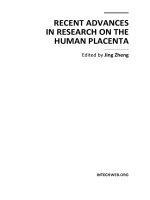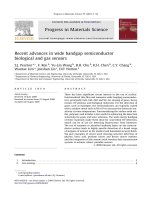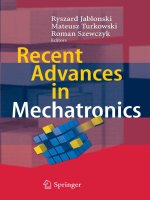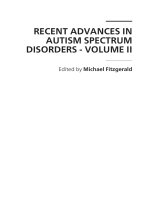RECENT ADVANCES IN AUTISM SPECTRUM DISORDERS - VOLUME II doc
Bạn đang xem bản rút gọn của tài liệu. Xem và tải ngay bản đầy đủ của tài liệu tại đây (5.61 MB, 194 trang )
RECENT ADVANCES IN
AUTISM SPECTRUM
DISORDERS - VOLUME II
Edited by Michael Fitzgerald
Recent Advances in Autism Spectrum Disorders - Volume II
/>Edited by Michael Fitzgerald
Contributors
Katarina Dodig-Ćurković, Mario Ćurković, Josipa Radić, Marianna Boso, Enzo Emanuele, Elizabeth Barron, Noemi
Piaggi, Giulia Scanferla, Matteo Rocchetti, Umberto Provenzani, Davide Broglia, Paolo Orsi, Roberto Colombo, Sara
Pesenti, Marta De Giuli, Elena Croci, Stefania Ucelli, Pierluigi Politi, Jenny Secker, Francesco Barale, Jane Yip, Fengyi
Kuo, Betsy Powers, Mark Tommerdahl, Eric Francisco, Penny Spikins, Ian Richard Freckelton, Donald Rojas, Kristina
McFadden, Segado Segado Vasquez, Shunit Reiter, Nirit Karni
Published by InTech
Janeza Trdine 9, 51000 Rijeka, Croatia
Copyright © 2013 InTech
All chapters are Open Access distributed under the Creative Commons Attribution 3.0 license, which allows users to
download, copy and build upon published articles even for commercial purposes, as long as the author and publisher
are properly credited, which ensures maximum dissemination and a wider impact of our publications. After this work
has been published by InTech, authors have the right to republish it, in whole or part, in any publication of which they
are the author, and to make other personal use of the work. Any republication, referencing or personal use of the
work must explicitly identify the original source.
Notice
Statements and opinions expressed in the chapters are these of the individual contributors and not necessarily those
of the editors or publisher. No responsibility is accepted for the accuracy of information contained in the published
chapters. The publisher assumes no responsibility for any damage or injury to persons or property arising out of the
use of any materials, instructions, methods or ideas contained in the book.
Publishing Process Manager Viktorija Zgela
Technical Editor InTech DTP team
Cover InTech Design team
First published February, 2013
Printed in Croatia
A free online edition of this book is available at www.intechopen.com
Additional hard copies can be obtained from
Recent Advances in Autism Spectrum Disorders - Volume II, Edited by Michael Fitzgerald
p. cm.
ISBN 978-953-51-1022-4
free online editions of InTech
Books and Journals can be found at
www.intechopen.com
Contents
Preface VII
Section 1
Evolution 1
Chapter 1
The Stone Age Origins of Autism 3
Penny Spikins
Section 2
Attitudes to Autism 25
Chapter 2
Attitudes Towards Autism Among Israeli Arab Teachers'
College Students 27
Karni-Vizer Nirit and Reiter Shunit
Section 3
Brain and Autism 45
Chapter 3
The Role of Cortical Modularity in Tactile Information
Processing: An Approach to Measuring Information Processing
Deficits in Autism 47
Eric Francisco, Oleg Favorov and Mark Tommerdahl
Chapter 4
Electrophysiology of Autism 73
Kristina L. McFadden and Donald C. Rojas
Section 4
Treatment 103
Chapter 5
The Sensory Experience of Toilet Training and Its Implications
for Autism Intervention 105
Jane Yip, Betsy Powers and Fengyi Kuo
VI
Contents
Chapter 6
The Recovery Orientation of a Farm Community for Severe
Autism — Data from the DREEM-IT (Developing Recovery
Enhancing Environment Measures — Italian Version) 129
Marianna Boso, Enzo Emanuele, Elizabeth Barron, Noemi Piaggi,
Giulia Scanferla, Matteo Rocchetti, Umberto Provenzani, Davide
Broglia, Paolo Orsi, Roberto Colombo, Sara Pesenti, Marta De Giuli,
Elena Croci, Stefania Ucelli, Francesco Barale, Jenny Secker and
Pierluigi Politi
Chapter 7
The Medical Treatment of Autism Disorders 137
Katarina Dodig-Ćurković, Mario Ćurković and Josipa Radić
Section 5
The Law and Autism 155
Chapter 8
Forensic Issues in Autism Spectrum Disorder: Learning from
Court Decisions 157
Ian Freckelton
Section 6
Architecture and Autism 175
Chapter 9
Autism and Architecture 177
Francisco Segado Vázquez and Alejandra Segado Torres
Preface
There is no doubt that the technological and scientific progress of homosapiens has been
hastened by persons with Autism Spectrum Disorders (Fitzgerald 2000 (a & b) 2004, 2005).
Spikins in her chapter illustrates the Stone Age origins of autism with reference to the ar‐
chaeological record and the Palaeolithic record. It is of critical importance to pay attention to
the positive aspects of autism.
The study of attitudes of people towards autism is of critical importance as the issue of a
stigma is still very prevalent in all countries even more so in non-western countries. KarniVizerNirit et al describes the attitudes towards autism among Israeli Arab teachers of col‐
lege students. They are particularly focused on inclusion. Interest in religious faith gave
some mothers strength. Coulthard and myself demonstrated this also some years ago
(Coulthard and Fitzgerald 1979, 1999). This study was also done on mothers of children with
Autism Spectrum Disorders.
Autism Spectrum Disorder is a brain based disorder. Francisco et al discusses the critical
importance of cortical modularity and information processing. They emphasise the smaller
than normal mini columns and deficient cerebral cortical GABAergic inhibitory neurotrans‐
mission. The issue of the mini columns also came up in a paper by Casanova et al 2007 in
relation to creativity. McFadden et al have written a complimentary chapter on the electro‐
physiology of autism. Indeed they point out that EEC studies in the future may help clini‐
cians to separate high-risk infants from typically developing infants. In terms of medical
treatment Dodig-Curkovic et al provide a comprehensive overview of medical treatment
and autism. It is often necessary to use medications in persons with autism.
Problems in toilet training are very common in autistic children. Yip et al explored this from
the sensory experience point of view in persons with Autism Spectrum Disorders. They pro‐
pose a putative sensory-neural understanding of the toilet training resistant cohort. Boso et
al describes the recovery orientation of a farm community for persons with severe autism.
Farm communities have considerable history for example in Ireland there was one devel‐
oped by the Irish Society for Autism and Pat Matthews. These communities provide impres‐
sive quality of life for persons with autism. Boso et al also described data using the
Developing Recovery Enhancing Environment Measures-Italian Version.
It is well know that persons with ASD get into difficulties with the law (Fitzgerald 2010) and
that there are higher rates of persons with ASD in prison than in the community. Freckelton
provides a very useful chapter from the court perspective of the forensic issues in relation to
Autism Spectrum Disorders. This gives a unique insight into a complex topic.
VIII
Preface
There are a relative paucity of papers on architecture on autism. Persons with autism are
very sensitive to the built environment and sensory issues are particularly relevant here. The
chapter by Segado Vazquez makes particularly interesting reading.
There is an overlap between autism and schizophrenia (Fitzgerald 2012) - the view that they
were separate is incorrect. It is disappointing that there is no biological marker for ASD and that
genetics has no influence on the treatment of ASD which is an extremely complex disorder.
Genes have multiple affects and often can give the features of ASD and creativity at the
same time. It is important that the positive as well as the disability elements are discussed
with families.
While the vast majority of persons with autism are highly moral and ethical, a tiny group
can get involved in serious crime e.g. school shootings, multiple murders etc. (Fitzgerald
2003, 2005 (a), 2005 (b), 2010). It is critical to take this group seriously and to take their
threats seriously to avoid a public catastrophe as we have seen in many countries.
Professor Michael Fitzgerald
Consultant Child & Adult Psychiatrist
Trinity College, Dublin
Ireland
Section 1
Evolution
Chapter 1
The Stone Age Origins of Autism
Penny Spikins
Additional information is available at the end of the chapter
/>
‘Their strengths and deficits do not deny them humanity but, rather, shape their humanity’
Grinker 2010: 173 [in [1]]
© 2013 Spikins; licensee InTech. This is an open access article distributed under the terms of the Creative
Commons Attribution License ( which permits unrestricted use,
distribution, and reproduction in any medium, provided the original work is properly cited.
4
Recent Advances in Autism Spectrum Disorders - Volume II
1. Introduction
1.1. Minds from a stone age past
Our modern societies have been said to house ‘stone age minds’ (see [2]). That is to say that
despite all the influences of modern culture our hard wired neurological make-up, instinc‐
tive responses and emotional capacities evolved in the vast depths of time which make up
our evolutionary past. Much of what makes us ‘human’ thus rests on the nature of societies
in the depths of prehistory thousands or even millions of years ago.
Looking back on the archaeological record of the early stone age there is much to be proud
of in our ancestry. Not only our remarkable intelligence but also our deep capacities to care
about others and work together for a common good come from evolutionary selection on
early humans throughout millions of years of the stone age. As far back as 1.6 million years
ago we have archaeological evidence from survival of illnesses and trauma that those who
were ill were looked after by others, and by the time of Neanderthals extensive care of the
ill, infirm and elderly was common, see [3,4]. From at least one million years ago we see evi‐
dence for widespread collaboration in hunting, in sharing food and in looking after increas‐
ingly vulnerable young. Stone age societies, much as recent hunter-gatherers such as the
Selk’nam of Tierra del Fuego (figure 1), lived in small groups who cared deeply about each
other, and worked together to survive.
Nonetheless our evolved minds also have a darker side. For most of our early existence, at
least until only around 100,000 years ago, human groups were relatively isolated, and much
of our common drive to identify ‘us’ and ‘them’ probably has its roots in a suspicion of ‘oth‐
ers’ which dates to this time. Studies of the remains of a group of Homo antecessor dating to
around 900,000 years ago at Atapuerca in northern Spain for example have revealed that
these people probably hunted and ate neighbouring groups to defend their territories (see
[5]). Small wonder that as a result we find ourselves far too often being afraid of those who
we feel are different from ourselves. Our neurological response to the pain of others for ex‐
ample can be tempered by whether we see them as belonging to the same group as our‐
selves or not (see [6]) and if we see people as different to ourselves we can even feel a sense
of pleasure at their pain (see [7]).
Thanks to our capacities for self-awareness and moral judgement we can make balanced de‐
cisions about how we treat others. Undoubtedly we must also influenced by our more recent
evolutionary history of a remarkably widespread collaboration. Indeed from 100,000 years
ago onwards we begin to see evidence for widespread links across different stone age
groups in many different parts of the world. In ice age Europe for example around 35-10,000
years ago marine shells travel over 2000km through exchange networks which helped pro‐
vide a social buffer to withstand shortfalls in resources (see [8]). Somehow these groups
overcame their tendencies to distrust outsiders and worked out ways of working together.
The Stone Age Origins of Autism
/>
Figure 1. Selk’nam hunter-gatherers from Tierra de Fuego on the move. Hunter-gatherer societies such as the
Selk’nam depend on high levels of collaboration for their survival. But do all minds need to be the same for collabora‐
tion to work, or are different minds a better recipe for success?
Our remarkable abilities to extend ourselves to care about others’ wellbeing can sometimes
be rather fragile. As the same time as being able to care about global issues or the wellbeing
of those we have never met, we can work hard to set up divisions which set us above others.
One can’t help but wonder if future societies may well look in disbelief at the plethora of
ways in which the twentieth and twenty-first centuries have found more detailed and elabo‐
rate ways to define a mentally ‘normal’ mind in contrast with a mentally different (and by
implication ‘wrong’) other. Whilst our abilities to deal with mental health issues have be‐
come ever more sophisticated, our ‘labelling’ of many conditions as disorders can fly in the
face of the more obvious reality that the human condition involves a great deal of suffering,
and not all of that suffering can be seen as ‘unnatural’.
Many so-called ‘disorders’ may be a natural part of humanity. Conditions such as anxiety or
depression are unwelcome but far from unnatural for example. Equally, genetically linked
conditions such as schizophrenia or bipolar disorder appear to have a long history, with
good evidence to suggest a role for those less grounded in reality in hunter-gatherer societ‐
ies as shaman (see [9]). Though a shaman’s apparent difference, and connection to another
world, may give them power, the trances experienced by shaman, and seen as providing a
link to the spirit world are more commonly painful than pleasurable. Their experience and
behaviour may have at times given them a certain social role in the past, but the same expe‐
rience is more typically seen as a disorder today.
It is within the context of a fashionable drive to label and classify ‘disorder’ that the la‐
bel of autism has emerged. Yet are autistic minds really ‘abnormal’ or ‘wrong’? We
would be well advised to be cautious of media warnings of an autism ‘epidemic’, word‐
ing which easily conjures up a picture of a growing disease threatening society. There is
every reason to suggest in contrast that what makes ‘us’ human is not a single ‘normal’
mind but a complex interdependency between different minds in which autism plays a
key role (see [10, 11, 12]). As Grinker (see [1]) illustrates autism should not deprive
5
6
Recent Advances in Autism Spectrum Disorders - Volume II
someone of humanity, but rather shape their (and our) humanity. Whilst the ‘story’ of
autism is nearly always told as beginning with its labelling in diagnosis by Kanner and
Asperger in the early 19th century (see [13]) autism may have much older roots, and a
more significant role to play in the emergence of our species. This much earlier ‘story’ of
the role of autism is an important one which accords a key role to autism in the emer‐
gence of humanity.
This chapter explores the potential stone age origins of autism, considering the contribution
which those with autism may have made to small scale prehistoric societies and the archaeo‐
logical evidence for a long time depth to the influence of autism.
2. Autism and society
Is autism part of what makes us ‘human’ today? Autism has traditionally been seen as a
condition of people somehow outside society. However recent research has challenged
this view, suggesting in contrast that autism is part of the processes that allow societies
work together.
Various authors have questioned whether autism, particularly high functioning autism or
aspergers syndrome, should always be seen as a disability (see [14, 15, 11, 12]). That is
not to say that life with aspergers syndrome is not often difficult or challenging or that
coping with having such a condition in a social world is not often distressing but that at
least at times it can sometimes be an advantage to have an ‘exact mind’ (see [16]). As‐
pergers syndrome often brings with it particular talents in a focus on detail, understand‐
ing of systems or abilities to concentrate on a particular problem (see [11]) and is
associated with heightened awareness of details, including musical pitch as well as sen‐
sory sensitivity (see [17]). High rates of those with aspergers syndrome characterise occu‐
pations such as engineering and mathematics (see [18]) as well in universities and the
legal system (see [19]). There may be many situations in which having aspergers syn‐
drome makes life difficult, but many of those with aspergers syndrome have a place in
society, making a valuable contribution.
Are people with autism motivated to be part of a greater social good? One of the key mis‐
conceptions of autism is that a ‘lack of empathy’ carries with it a tendency to care far less
about others wellbeing than the ‘neurotypical’ might. However empathy comprises a cogni‐
tive and an affective component (understanding others feelings and caring about others feel‐
ings). The affective component, how much someone will care about others, has been shown
to be intact in autism (see [20]). People with autistic spectrum conditions ‘care’ about others
wellbeing as much as anyone else might (even if their abilities to intuitively sense others
feelings are impaired), often channelling such concerns into wider social endeavours such as
a drive for fairness and justice (see [11]) or scientific progress. Autism implies that people
care about others in a different way.
The Stone Age Origins of Autism
/>
Are people with autism really part of human social life? A further misconception is that
those with asperger’s syndrome are unsocial. Anthropological studies of autism have
made a significant impact on our understanding of what it is to be autistic and social
and shown that whilst ‘autistic sociality’ is notably different those with autism are not
less social. Autistic sociality may often be focused on exchanging knowledge rather than
sharing feelings or extended narratives, and is often mediated through the material
world (today made up of books or computers). Autism means that people are social in a
different way (see [13]).
Even those with severe autism can share a sociality which binds them to others. Solomon (in
[21]) for example describes Sacks account of two severely autistic twins, John and Michael,
who were institutionalised from childhood. In their early twenties and delighted in sharing
mathematical concepts and ‘conversing’ in prime numbers.
Sacks writes:
They were seated in a corner together, with a mysterious secret smile on their faces, [...] en‐
joying the strange pleasure and peace they now seemed to have.[...] They seemed to be
locked in a singular, purely numerical, converse. John would say a number—a six-figure
number. Michael would catch the number, nod, smile and seem to savour it. Then he, in
turn, would say another six-figure number and now it was John who received and appreci‐
ated it richly. They looked, at first, like two connoisseurs wine-tasting, sharing rare tastes,
rare appreciations. (Sacks 1970: 202, in [22])
The twins happily welcome Sacks to their conversation when he joins in with his own prime
numbers. They provide an example of how apparently extremely autistic individuals can
connect socially to others, and derive pleasure from their social contribution and connection,
albeit in a non-typical manner. Sadly the different nature of their communication lead them
to be separated to prevent them communicating in this ‘non-normal’ manner.
Whilst it is clear that for the twins pleasurable social life may be distinctive from the norm,
in many ways this type of connection is not uncomparable to motivations and pleasures of
scientific endeavour as described by Nikola Tesla (see [23]).
I do not think that there is any thrill that can go through the human heart like that felt by the
inventor as he sees some creation of the brain unfolding to success … Such emotions make a
man forget food, sleep, friends, love, everything … I do not think you can name many great
inventions made by married men. (see [24]).
Not only rare geniuses like Darwin or Einstein may have been autistic (see [25, 26, 27, 28])
but many more common and far less obviously distinctive members of society may have
minds that are distinctively different from what we see as ‘typical’, and add something criti‐
cal to what makes us ‘human’.
7
8
Recent Advances in Autism Spectrum Disorders - Volume II
2.1. Inherited gifts of insight and action?
‘I feel sure that my way of being is only a disability of context, that what have been labelled
symptoms of autism in the context of my culture are inherited gifts of insight and action’
Dawn Prince (in [29])
As Dawn Prince comments, autism can be seen as a disability of context. How we view ex‐
pressions of autism, whether as laudable and productive (such as an extreme focus on scien‐
tific discovery to the exclusion of other concerns for example) or as unproductive and
threatening (in the case of the mathematical communication of the twins studies above) is
greatly dependant on our culture. Whereas all cultures will have some limits to the nature of
unusual behaviours that could be readily supported by others (and severe autism may never
be an advantage), some may have been more accommodating of autistic difference than oth‐
ers, and in turn benefitted from what autism may have brought to society (figure 2).
Figure 2. Social means of accommodating autism (or other differences in mind) and the resulting nature of cognitive
differences.
Dawn Prince’s observation that autism brings with it inherited gifts of unique insight and
action itself gives us a unique insight into the potential contribution which in certain contexts
autism may have made societies in the far distant past as well as the present.
2.1.1. Unique insight
Baron-Cohen (in [30]) describes the main areas of talents in autism. These talents derive
from a drive to understand systems, and illustrate the domains in which unique insights of‐
ten lie.
The major kinds of system focused on by those with autism include:
• collectible systems (e.g. distinguishing between types of stones or wood);
• mechanical systems (e.g. a video recorder or a window lock);
• numerical systems (e.g. a train timetable or a calendar);
The Stone Age Origins of Autism
/>
• abstract systems (e.g. the syntax of a language or musical notation);
• natural systems (e.g. the weather patterns or tidal wave patterns);
• social systems (e.g. a management hierarchy or a dance routine with a dance partner);
• motoric systems (e.g. throwing a Frisbee or bouncing on a trampoline).
Restricted or circumscribed interests shown by children with autism (figure 3), and
which tend to fall into these domains may be difficult for parents to manage, but are of‐
ten also seen as related to unique strengths or talents (see [31, 32]). An obsession with
weather patterns as a child for example may in some lead to a particular strength and
an academic focus on meteorology as an adult. Many famous scientists appear to show
autistic traits. Isaac Newton’s unique insights into astronomy for example derive from a
particularly focused motivation to understand the systems behind the movements of as‐
tronomical features (figure 4).
Figure 3. An eight month old boy with autism obsessively stacking cans (source: Wikimedia commons)
9
10
Recent Advances in Autism Spectrum Disorders - Volume II
Figure 4. Sir Isaac Newton's depiction of the orbit of the Comet of 1680, fit to a parabola. The Mathematical Principles
of Natural Philosophy. London: Benjamin Motte, 1729: 358. (Wikimedia Commons)
In a stone age context a focus on fine scale technological prowess or understanding and pre‐
diction of nature has an obvious contribution, particularly in harsh and risky high latitude
environments such as the Arctic where survival depends on technology occupation depends
on highly technological systems. The Inuit for example use complex multi-component har‐
poons to fish for seal, finely engineered dog sleds and highly efficient hunting equipment.
2.2. Autism and material culture
Though subtle, certain differences in the material culture selected and created by those with
autism reflect their different minds. Thus we can argue that it ought to be possible to dis‐
criminate the material record of a society which includes or even encourages autistic traits
from those where autism is unsupported.
Children and adults with autism use and create the world around them in subtly differ‐
ent ways, though it is children who have been studied most intensively. Children diag‐
nosed with autistic spectrum disorder tend to engage differently with toys, for example
focusing on spinning objects or lining up toys, and seem to derive comfort from precise
ordering or regular patterning (see [33]) as seen above. Adults in turn, even if high func‐
tioning and not usually detectable as ‘different’, relate differently to the material world
around them, tending to find comfort in ordered patterns. A focus on understanding sys‐
tems leads to detailed record keeping and scientific insights. Baron-Cohen (in [30]) for exam‐
ple notes the precise recordings of weather patterns in the notebooks of Kevin Phelps
and equivalent focus often drives scientific genius. A drive to understand and experi‐
ment is related to the creation of inventions or technological innovation (with aspergers syn‐
drome being associated with families of engineers, see [18]).
The Stone Age Origins of Autism
/>
Differences in perception also influence the creation and use of objects. Children with au‐
tism notice the numbers on telegraph poles, and differences in perception lead to adults no‐
ticing and dealing with finer details than others might. Autistic art is thus notably distinct. The
art of Nadia, an autistic ‘savant’ for example is typical in being extraordinarily detailed, in
common terms a representation of ‘the parts’ rather than ‘the whole’ (or the trees rather than
the wood), figure 5, and in contrast to figure 6 (in [34]). The same pattern is seen in the art of
Peter Myers (see [16]), who also shows remarkable talent in embedding illusions within his
work. Kellman (in [35]) argues that differences in visual perception creates the distinctive
features of autistic art, alongside the unique focus that a lack of perception of some other
areas of external environment can bring.
Figure 5. Horse and rider completed at approximately 5 years 6 months by Nadia. Selfe 2011: figure 2.7: p32 (with
kind permission Lorna Selfe).
11
12
Recent Advances in Autism Spectrum Disorders - Volume II
Figure 6. Two riders drawn by non-autistic children aged 6 years. Selfe: 2011 (figure 2.10, p35). With kind permission
Lorna Selfe.
2.2.1. Action
As well as driving detailed recording, fine scale understanding and new innovations of the
natural world, autism may also be related to particular types of action in other more social
ways. Whilst empathising leads to tendencies to follow allegiances (see [36]) autism leads to
a focus on strict fairness in social relationships regardless of any particular allies (see [11]).
An autistic creation of rigidly clear rules and obsessively fair social behaviour may thus play
a key role in defining the ‘rules’ or legal systems which allow cooperation between unfami‐
liar people and constrain exploitation, explaining an association in the present between as‐
perger’s syndrome and the legal profession (see [19]). Those with autism appear to play a
key role in the creation and enforcement of rigid social rules.
Clues to the significance of defined rules of social behaviour for stone age societies can be
found in modern hunter-gatherers. Amongst the Inuit for example, as with most huntergatherers, connections to external groups and collaborations at times of crisis work through
rigid systems of defined behaviour, rather than being driven by a far messier suite of com‐
plex allegiances or personal favours.
The Stone Age Origins of Autism
/>
In the northern Canada the Netsilik Inuit for example had a highly rule based system called
niqaiturasuaktut which is used to ensure ‘fair’ sharing during collaborative winter seal hunts
(see [37]). After a hunter kills a seal sharing partners are defined by a combination of inheri‐
tance and naming and decided by the males of the family. A particular woman divides the
carcass and actually shares it with the other partners. The division must follow specific
rules. The seal meat and blubber is divided amongst 14 partners, with the first 7 being the
most important. The hunter himself only keeps the flippers, so relying on a repeat of the sys‐
tem in future hunts to provide him with meat for himself. These elaborate and rigidly de‐
fined rules prevent emotionally driven personal allegiances from influencing the sharing of
resources and provide a system by which those who might not usually work together can
collaborate for a common good.
The incorporation of an autistic obsession with fairness and rules may have been key to provid‐
ing highly systemised conventions to circumvent any tendencies to follow allegiances, or react
emotionally to the unfamiliar and so may have been critical in promoting collaboration be‐
tween different groups. It is not unreasonable to suggest that the widespread connections, ex‐
change of materials and collaboration at times of need which we see after around 100,000 years
ago may have been driven by the inclusion of autistic minds into societies. These types of sys‐
tems may have been the key for example to allowing upper Palaeolithic groups to collaborate
across large regions to survive local famines during the severe environments of ice age Hein‐
rich events (see [38]).
Autism may often be a disadvantage where intuitive understanding of others is important,
and can be unhelpful to the emotional wellbeing of others. Nonetheless where they could be
integrated and supported, at a certain level a few individuals at the extreme of the spectrum
of mind may have made an important contribution to past societies both in technological
and social domains.
3. Autism and the archaeological record of the Palaeolithic
In the light of the potential value of autistic insight and action in certain contexts it is possi‐
ble to view the archaeological record rather differently. Rather than a progressive sophistica‐
tion of a single human ‘mind’, a more plausible explanation for much of the patterning in
the archaeological record is as the marked emergence of autistic traits within a modern ‘hu‐
manity’ made up of complex interrelationship between different minds.
The earliest evidence for any autistic characteristics emerges well after the split between our
own species and our nearest relatives the Neanderthals (occurring around 500,000 years
ago), perhaps unsurprisingly as some of the key genes for autism have been found to be
lacking in the Neanderthal genome (see [39]) and that of the other closely related species to
modern humans, the Denisovans (see [40]).
However after 100,000 years ago various elements of the archaeological record document
certain new traits which appear to be linked to autism – such as a unique focus on detail,
13
14
Recent Advances in Autism Spectrum Disorders - Volume II
technological innovation, and understanding of complex systems (see [10]) as well as evi‐
dence for large scale collaborations in the exchange of materials between groups (see [41]).
Many of these new elements can be associated with what has been termed the appearance of
‘modern human behaviour’.
After around 100,000 years ago we begin to relatively suddenly see the emergence of ‘inven‐
tions’ such as the spear thrower, multi-component harpoon and tiny microlithic stone tools
(figure 7 & 8) which appear to have been essential for the colonisation of previously unoccu‐
pied regions such as the far north (see [42]).
Figure 7. A ‘microlith’, these tiny tools formed part of barbs in arrow shafts, as well as other uses, and were highly
efficient ways of making effective hunting weapons as well as maximising the use of stone tools materials and the
efficiency and maintainability of tools with individual microliths being replaceable. With kind permission José-Manuel
Benito Álvarez.
Figure 8. Microliths, forming part of highly engineering technologies, only appear after about 100,000 years ago.
These microliths are from Red Ratcher Late Mesolithic site in the Pennines (courtesy of Paul Preston).
For example changes in ‘modern human’ technology include the appearance of tiny micro‐
lithic points such as at Howieson’s Poort and Rose Cottage in South Africa at around 75,000
years ago. Other innovations in Africa at his time including finely made bifacial points made
The Stone Age Origins of Autism
/>
on raw materials which may have been derived from structured exchange networks, bone
tools, new symbolic art such as engraved patterns on ochre and ostrich eggshell and the for‐
mal ordering of space on sites (see [44]). Microliths and other elements of ‘modern’ behav‐
iour are also later found at Patne in India, following the presumed colonisation of the
southern corridor by fully modern humans (see [45]).
Somewhat later in Ice Age Europe, around 35-10,000 years ago, we see potential further evi‐
dence for a stone age context in which autism may have played an important social role.
Firstly, a number of artefacts found at European Upper Palaeolithic sites illustrate a unique
focus on recording and understanding natural systems, particularly astronomical systems,
which parallels with that seen in those with aspergers syndrome today. The Taï plaque for
example, a 9cm long engraved bone from the Grotte de Taï, dated to around 10,000 years
ago (see [43, 46]) is covered with many notches interpreted as a calendrical notation span‐
ning over a year (figure 9).
Figure 9. The Taï plaque (Marshack 1991: figure 1, p26.[43])
The Abri Blanchard plaquette, dated from around 32,000 years ago is perhaps even more re‐
markable. The patterns on this bone record the phases of the moon and its position in the sky re‐
lated to a notched co-ordinate system at the edge of the plaque (figure 10, see [47, 46, 48]).
As well as other artefacts which also appear to carry calendrical, astronomical or other nota‐
tion there are also other hints of autistic influence. The Raymonden plaquette from around
12,000 bp for example illustrates an autistic like approach to social relationships. This bone
features an extended bison skeleton, with figures sitting on either side of the spine, illustrat‐
ing both a detailed anatomical knowledge of anatomy (showing individual vertebrae) and
with a focus on equal or systematically defined sharing (figure 11).
The most famous example of a link between autism and the contemporary archaeological
record of this period however comes from the famous art. Upper Palaeolithic art in southwestern europe is dominated by often extraordinarily realistic and naturalistic depictions of
animals, both on cave walls (see front figure and figure 12) and in portable art (see figure
13). A number of elements of this art, such as highly realistic detailed figurative representa‐
tion, a focus on parts (with drawings often overlapping) and a remarkable visual memory
from what can only have been limited opportunities to note details of dynamic animals are
found in common with autism (see [49, 35, 50, 10]). Whilst we might not necessarily suggest
15
16
Recent Advances in Autism Spectrum Disorders - Volume II
that the ice age artists were autistic themselves, it would not be unreasonable to conclude
that autistic perception and the influence of those with autism on society had a significant in‐
fluence on the style of art.
Figure 10. The Abri Blanchard plaquette (De Smedt and Cruz 2011: figure 1, with kind permission).
Figure 11. Raymonden plaque, c10,000 years old, Raymonden, Dordogne, southern France (image: museo de Altamira).
The Stone Age Origins of Autism
/>
Figure 12. B. & G. Delluc viewing frieze of swimming reindeer in Lascaux cave, Dorgdogne c 20,000 years old.
Figure 13. Line of animal heads engraved on a rib from the cave of Courbet, Penne-Tarn, France, Late Magdalenian,
about 12,500 years ago (source: Wikimedia Commons)
The patchy nature of the expression of autistic traits in post 100,000 bp archaeological evi‐
dence suggests that it may have been most particularly in certain times and places that the
advantages of autism were particularly emphasised. The clearest context may be that of
highly risky, cold climate environments such as Ice Age Europe. Here both the dependence
on technology for survival is greatest, and technological efficiency and innovation much val‐
ued, and unstable climates place an emphasis on large scale collaborations to provide a so‐
cial buffer against shortfalls in resources. The archaeological record of southernmost Africa
provides another particularly interesting case where autistic traits appear to be have adopt‐
ed early at Blombos and Rose Cottage, later declined around 65,000 years ago and then readopted many thousands of years later continuing into elements of modern San technology
(see [51]). If those with autism were integrated into societies at different times and places it
17









